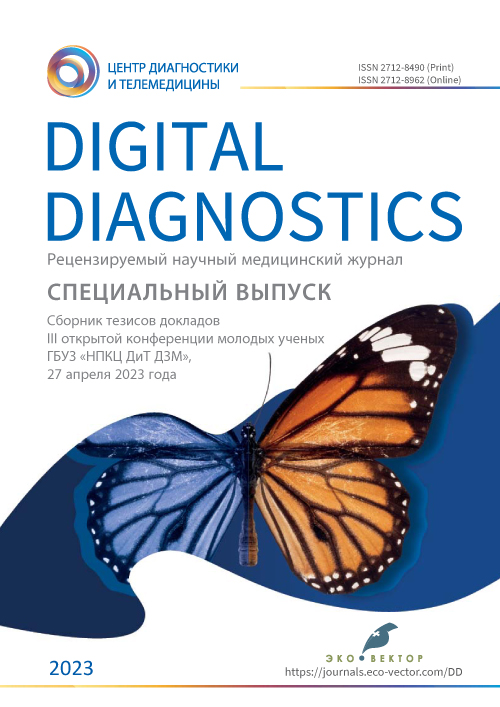Effect of extrapleural silicone filling on lung function in patients with bilateral destructive tuberculosis
- Авторлар: Donchenko D.V.1, Chushkin M.I.1, Krasnikova E.V.1, Bagirov M.A.1
-
Мекемелер:
- Central Scientific Research Institute of Tuberculosis
- Шығарылым: Том 4, № 1S (2023)
- Беттер: 40-42
- Бөлім: Conference proceedings
- ##submission.dateSubmitted##: 18.05.2023
- ##submission.dateAccepted##: 18.05.2023
- ##submission.datePublished##: 26.06.2023
- URL: https://jdigitaldiagnostics.com/DD/article/view/430339
- DOI: https://doi.org/10.17816/DD430339
- ID: 430339
Дәйексөз келтіру
Толық мәтін
Аннотация
BACKGROUND: Despite the success of the fight against tuberculosis, the proportion of patients with multidrug- and extensively drug-resistant pathogens continues to grow. According to the World Health Organization, the effectiveness of treating patients with multidrug- and extensively drug-resistant mycobacterium tuberculosis (MBT) worldwide is 48% and 34%, respectively. The lack of efficiency of chemotherapy in this category of patients leads to complex surgical treatment of tuberculosis.
AIM: To investigate the effect of surgery on respiratory function of staged surgical treatment with extrapleural silicone filling (ESF) in patients with bilateral destructive pulmonary tuberculosis.
METHODS: From 2012 to 2022, extrapleural pneumolysis with silicone implant filling in combination with lung resection on the opposite side was performed in 14 patients with extensive bilateral destructive tuberculosis. The control group included 29 patients who underwent lung resection on both sides. The groups were comparable in terms of sex, age, form of the underlying disease, and spectrum of MBT drug sensitivity. External respiratory function was studied by forced spirometry on Master Screen Pneumon devices by Viasys Healthcare with determination of forced volume vital capacity (FVVC) and forced expiratory volume per 1 s (FEF1).
RESULTS: The dynamics of spirometric parameters after surgical treatment were as follows: FVVC was –1.05±0.47 and –1.74±0.76 liters (p <0.05), and SPH1 was –0.95±0.6 and –1.33±0.5 liters (p <0.05) in the ESF group and in the resection group, respectively. In the main group 10 (70%) patients showed diverse changes of the ventilatory function. Thus, 5/14 (35%) patients had worsening, whereas 5/14 (35%) patients had increased functional indices. In the main group, the decrease in respiratory indices was significantly lower compared with the control group, indicating the effectiveness of the proposed technique. Staged surgical treatment with both bilateral consecutive resections and the use of ESF in combination with resection on the opposite side was accompanied by a decrease in pulmonary ventilatory function. In the group of ESF patients, a moderate decrease in the indices was observed.
CONCLUSIONS: When choosing surgical treatment using extrapleural pneumolysis with silicone implant filling, ESF should be performed at the first stage to preserve the maximum ventilatory function of the lungs. The use of ESF in staged surgical treatment of patients with extensive destructive tuberculosis allows expanding the functional operability of patients with limited respiratory reserves.
Негізгі сөздер
Толық мәтін
BACKGROUND: Despite the success of the fight against tuberculosis, the proportion of patients with multidrug- and extensively drug-resistant pathogens continues to grow. According to the World Health Organization, the effectiveness of treating patients with multidrug- and extensively drug-resistant mycobacterium tuberculosis (MBT) worldwide is 48% and 34%, respectively. The lack of efficiency of chemotherapy in this category of patients leads to complex surgical treatment of tuberculosis.
AIM: To investigate the effect of surgery on respiratory function of staged surgical treatment with extrapleural silicone filling (ESF) in patients with bilateral destructive pulmonary tuberculosis.
METHODS: From 2012 to 2022, extrapleural pneumolysis with silicone implant filling in combination with lung resection on the opposite side was performed in 14 patients with extensive bilateral destructive tuberculosis. The control group included 29 patients who underwent lung resection on both sides. The groups were comparable in terms of sex, age, form of the underlying disease, and spectrum of MBT drug sensitivity. External respiratory function was studied by forced spirometry on Master Screen Pneumon devices by Viasys Healthcare with determination of forced volume vital capacity (FVVC) and forced expiratory volume per 1 s (FEF1).
RESULTS: The dynamics of spirometric parameters after surgical treatment were as follows: FVVC was –1.05±0.47 and –1.74±0.76 liters (p <0.05), and SPH1 was –0.95±0.6 and –1.33±0.5 liters (p <0.05) in the ESF group and in the resection group, respectively. In the main group 10 (70%) patients showed diverse changes of the ventilatory function. Thus, 5/14 (35%) patients had worsening, whereas 5/14 (35%) patients had increased functional indices. In the main group, the decrease in respiratory indices was significantly lower compared with the control group, indicating the effectiveness of the proposed technique. Staged surgical treatment with both bilateral consecutive resections and the use of ESF in combination with resection on the opposite side was accompanied by a decrease in pulmonary ventilatory function. In the group of ESF patients, a moderate decrease in the indices was observed.
CONCLUSIONS: When choosing surgical treatment using extrapleural pneumolysis with silicone implant filling, ESF should be performed at the first stage to preserve the maximum ventilatory function of the lungs. The use of ESF in staged surgical treatment of patients with extensive destructive tuberculosis allows expanding the functional operability of patients with limited respiratory reserves.
Авторлар туралы
Daria Donchenko
Central Scientific Research Institute of Tuberculosis
Хат алмасуға жауапты Автор.
Email: donchenkodarya@mail.ru
ORCID iD: 0009-0003-0965-6882
SPIN-код: 2163-9550
Ресей, Moscow
Mikhail Chushkin
Central Scientific Research Institute of Tuberculosis
Email: el.krasn@gmail.com
ORCID iD: 0000-0001-8263-8240
Ресей, Moscow
Elena Krasnikova
Central Scientific Research Institute of Tuberculosis
Email: el.krasn@gmail.com
ORCID iD: 0000-0002-5879-7062
Ресей, Moscow
Mammad Bagirov
Central Scientific Research Institute of Tuberculosis
Email: bagirov60@gmail.com
ORCID iD: 0000-0001-9788-1024
Ресей, Moscow
Әдебиет тізімі
Қосымша файлдар










